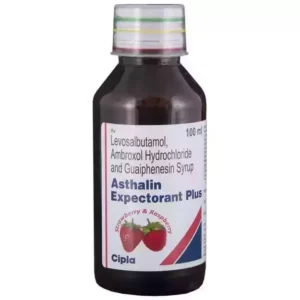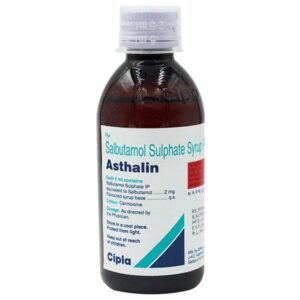SALBUTAMOL + GUAIPHENESIN
Salbutamol: Salbutamol, also known as albuterol, is a medication commonly used to treat asthma, chronic obstructive pulmonary disease (COPD), and other respiratory conditions. It belongs to a class of drugs called beta-agonists, which work by relaxing the smooth muscles of the airways, allowing easier breathing.
The main use of salbutamol is to relieve and prevent symptoms such as wheezing, shortness of breath, chest tightness, and coughing associated with asthma and COPD. It is usually delivered through inhalation using an inhaler or a nebulizer.
Salbutamol acts on beta-2 adrenergic receptors in the smooth muscles of the lung, causing them to relax and dilate the airways. This allows for increased airflow and improved breathing. It also helps to reduce inflammation and mucus production in the airways.
The dose of salbutamol may vary depending on the individual and the severity of the condition. The usual recommended dose for adults is 1 to 2 inhalations (100-200 micrograms) every 4-6 hours as needed. For children, the dose is typically lower, based on age and weight.
Common side effects of salbutamol include tremors, increased heart rate, headache, dizziness, nervousness, and muscle cramps. These side effects are usually mild and temporary. In rare cases, serious side effects such as chest pain, irregular heartbeat, allergic reactions, and changes in blood pressure may occur, and immediate medical attention should be sought.
It is important to note that salbutamol is a short-acting reliever medication and should not be used as a long-term asthma controller. It is recommended to consult a healthcare professional for an appropriate treatment plan and to discuss any concerns or potential interactions with other medications.
Guaiphenesin: Guaifenesin is an over-the-counter drug commonly used as an expectorant. It is used to relieve chest congestion caused by excessive mucus and phlegm in the airways and respiratory tract. It is available in various forms including tablets, capsules, and syrups.
The mechanism of action of guaifenesin is not completely understood. However, it is believed to work by thinning and loosening mucus secretions in the lungs and airways, making it easier to cough out.
The recommended dose of guaifenesin may vary depending on the formulation and the age of the patient. Generally, for adults and children aged 12 years and above, the usual recommended dose is 200-400 mg every 4 hours, not exceeding 2.4 grams (2400 mg) in a 24-hour period. For children aged 6-11 years, the typical dose is 100-200 mg every 4 hours, not exceeding 1.2 grams (1200 mg) in a 24-hour period. It is important to follow the instructions on the packaging or consult a healthcare professional for the correct dosing.
Common side effects of guaifenesin can include nausea, vomiting, dizziness, stomach upset, and headache. These side effects are usually mild and temporary. However, if these side effects worsen or persist, a healthcare professional should be consulted.
Guaifenesin is generally well-tolerated and considered safe for most people when used as directed. However, it may interact with other medications, so it is important to inform a healthcare professional about any other drugs you are taking before using guaifenesin. Additionally, certain individuals, such as those with kidney disease or allergies to guaifenesin or its ingredients, should avoid using the drug or consult a doctor for appropriate guidance.


